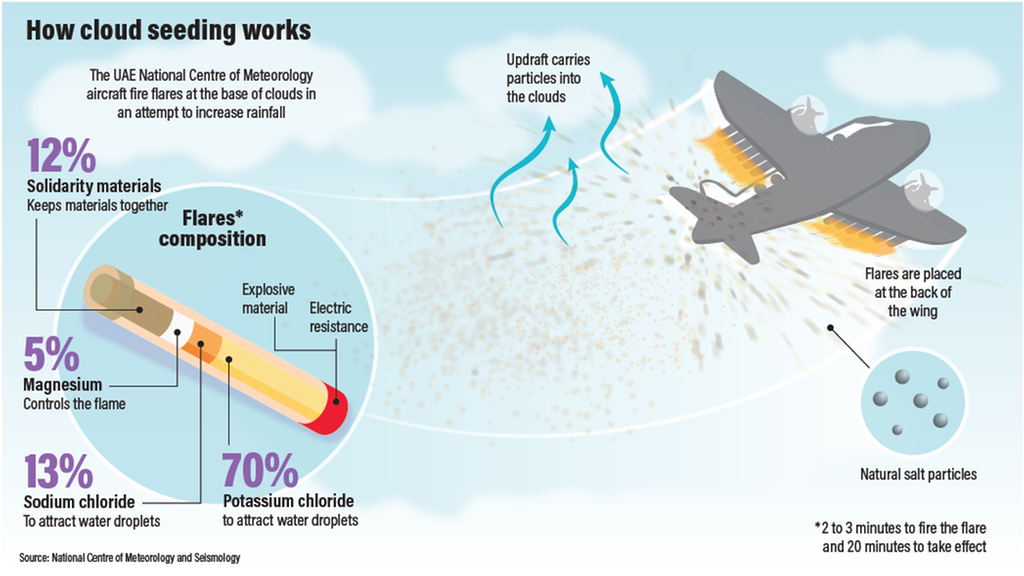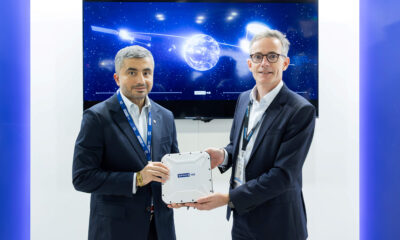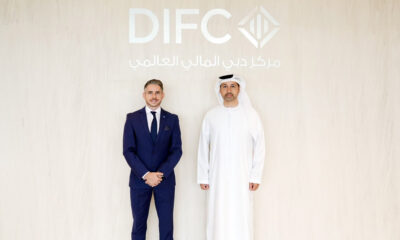News
UAE To Unleash Hordes Of Cloud-Triggering Drones

The United Arab Emirates (UAE) has a massive problem with a limited supply of rainwater. With an average rainfall of just 100 mm per year, the constitutional monarchy is ranked among the most water-stressed countries in the world.
For years now, the country’s government has been investing heavily in various cloud-seeding missions aimed to increase the annual rainfall. For example, the UAE has been relatively successfully triggering rain by firing salt particles into clouds from airplanes to make individual water particles heavier and more likely to punch holes in the clouds.

National Centre Of Meteorology & Seismology
Now, UAE scientists have partnered with their colleagues from the University of Reading, England, to make it rain more in the parched country by literary giving clouds electric shocks.
“Equipped with a payload of electric charge-emitting instruments and custom sensors, these drones will fly at low altitudes and provide an electric charge to air molecules, which should stimulate precipitation,” explains Alya Al-Mazroui, the Director of the UAE Research Program for Rain Enhancement Science.
By deploying an electric current with negative and positive ions, the drones will basically attempt to recreate the natural phenomenon that causes dry hair to be attracted to a plastic comb. Since particles with opposite charges attract each other, the electricity unleashing drones should theoretically cause small droplets of water to merge into more subscription cloud formations and eventually lead to rain.
Also Read: Amazon Is Planning To Create Over 1,500 Jobs In Saudi Arabia
“Our project aims to evaluate the importance of charge in affecting the cloud droplet size distribution and rainfall generation through modifying the behavior of droplets and particles and studying the microphysical and electric properties of fog events,” says Professor Giles Harrison, a Professor of Atmospheric Physics in the Department of Meteorology at the University of Reading.
The effectiveness and safety of various cloud-seeding practices, including those explored by the UAE, are still debated by scientists. Concerns have been raised about their geopolitical implications, with wealthy, technologically advanced countries potentially “stealing” rainwater that would otherwise naturally end up in poorer countries.
News
Alienware Just Announced Six New Gaming Monitors
The new models include three QD-OLED and three budget-friendly QHD options, expanding the company’s lineup for all gamers.

Alienware has just updated its gaming monitor lineup with six new additions, including the highly anticipated Alienware 27 4K QD-OLED Monitor. The latest wave of releases is set to reach more gamers than ever, offering high-end QD-OLED displays alongside more budget-friendly options.
The latest displays clearly show that the company is doubling down on QD-OLED with three new models sporting the technology. A redesigned Alienware 34 Ultra-Wide QD-OLED Monitor is also making a return, further refining what is already a fan-favorite display.
A Unified Design: The AW30 Aesthetic
All six monitors feature Alienware’s new AW30 design language, first introduced at CES. The AW30 aesthetic brings a futuristic, minimalist look that unites the entire lineup under a cohesive visual identity.
Pushing QD-OLED Even Further
The refreshed Alienware 34 Ultra-Wide QD-OLED Monitor (AW3425DW) builds on its predecessor’s success with a 240Hz refresh rate (up from 175Hz) and HDMI 2.1 FRL support. It also gains G-SYNC Compatible certification alongside AMD FreeSync Premium Pro and VESA AdaptiveSync, ensuring ultra-smooth performance. With a WQHD (3440×1440) resolution and an 1800R curve, this display enhances immersion for both gaming and cinematic experiences.
For those who crave speed, the Alienware 27 280Hz QD-OLED Monitor (AW2725D) pairs a high refresh rate with QHD resolution, balancing sharp visuals with ultra-smooth gameplay. Meanwhile, the Alienware 27 4K QD-OLED Monitor (AW2725Q) delivers stunning clarity with an industry-leading pixel density of 166 PPI, making it the sharpest OLED or QD-OLED monitor available.
Also Read: Infinite Reality Acquires Napster In $207 Million Deal
Worried about OLED burn-in? Alienware’s entire QD-OLED lineup comes with a three-year limited warranty covering burn-in concerns, offering peace of mind for gamers investing in these high-end displays.
Bringing QHD To A Wider Audience
Alongside QD-OLED, Alienware is also releasing three new QHD gaming monitors aimed at more price-conscious gamers. The Alienware 34 Gaming Monitor (AW3425DWM), Alienware 32 Gaming Monitor (AW3225DM), and Alienware 27 Gaming Monitor (AW2725DM) provide a range of sizes and formats to suit different preferences:
- The Alienware 34 Gaming Monitor (AW3425DWM): An ultrawide (WQHD) option for a panoramic, immersive experience.
- The Alienware 32 Gaming Monitor (AW3225DM): A standard 16:9 panel for a traditional but expansive desktop setup.
- The Alienware 27 Gaming Monitor (AW2725DM): A 27” display offering the same performance in a more compact form factor.
All three gaming monitors feature a fast 180 Hz refresh rate, a 1ms gray-to-gray response time, and support for NVIDIA G-SYNC, AMD FreeSync, and VESA AdaptiveSync to eliminate screen tearing. Additionally, with 95% DCI-P3 color coverage and VESA DisplayHDR400 certification, these displays deliver vibrant colors and high dynamic range for lifelike visuals.
-

 News3 weeks ago
News3 weeks agoSpace42 & Cobham Satcom Launch New Satellite Broadband Terminal
-

 News3 weeks ago
News3 weeks agoRipple Gains DFSA License To Offer Crypto Payments In Dubai
-

 News2 weeks ago
News2 weeks agoAre You Ready For Hong Kong’s InnoEX & Electronics Fair?
-

 News2 weeks ago
News2 weeks agoWizz Air Abu Dhabi Adds Beirut Flights Amid Tourism Revival



















